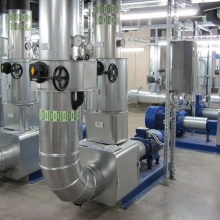At the High-Performance Computing Center Stuttgart (HLRS), running one of Europe's fastest supercomputers also means operating its infrastructure in a sustainable manner. Ten years ago, HLRS began an intensive engagement with environmental protection. Its achievements have since been certified according to the Eco-Management and Audit Scheme (EMAS) and the Blue Angel ecolabel, among others. In the future HLRS will continue improving its efforts towards sustainability, including through two new projects that will both improve energy efficiency at the center and help to identify best practices for sustainability in the field of information technology more broadly.
"Sustainability and climate protection are central concerns of the state government — this also applies to the IT sector," said Baden-Württemberg Minister of Science Theresia Bauer. "The fact that an international beacon like HLRS is living its sustainability concept in such an exemplary way is especially valuable considering the importance of climate protection in digitalization and AI. I would like to thank everyone at HLRS who has been involved and hope that the center will continue to be ambitious in its pursuit of sustainable and innovative approaches." HLRS's environmental management system was developed under the auspices of the project "Sustainability in HPC Centers," which was funded by the Baden-Württemberg Ministry for Science, Research and Art.
"After 10 years of developing and implementing our comprehensive sustainability strategy, we not only see a wide range of positive effects at HLRS but are also proud to be paving the way toward a new way of thinking and behaving at the intersection of energy and IT development," said Prof. Dr. Michael Resch, Director of HLRS.
Best Practices for Sustainability in Data Centers
In 2020 HLRS became the first high-performance computing center of its size to be certified by EMAS — the world's most demanding program for environmental management — and by the Blue Angel ecolabel for Energy-Efficient Data Center Operation. The center's comprehensive environmental management plan ensures that its computing and cooling systems are operated as efficiently as possible. In addition, it details sustainability policies that affect the entire organization, addressing the procurement of new products, waste disposal, and the preservation of species diversity on the property surrounding its buildings, among other topics. Certification also means that HLRS has committed itself to continually improve its environmental performance and to share its expertise with other data centers. "With increasing digitalization it is becoming increasingly important that HLRS not only continue to further develop its ambitious improvement process, but also to help other organizations to become more sustainable," Resch said. A handbook called "Sustainability in Computing Centers: A Practical Guide" is a first step in this direction. According to the motto "Imitation Invited," HLRS has made the guide available for other computing centers interested in improving their environmental performance.
Building Planning Will Include Sustainability Measures
Sustainability is also a central concern in the design of a new computing building at HLRS, which is currently in its planning phase and whose opening is envisioned for 2026. Among the key issues being considered are the optimization of the building's energy supply, its cooling system, and the recycling of its waste heat for other uses.
Improving Energy Efficiency in the IT Sector Outside the University
In addition, HLRS has recently started two new research projects that will focus on improving sustainability in other data centers. HLRS is leading a project called ENRICH (Energy, Sustainability, and Resource Efficiency in IT and Computing Centers), which will develop an digitalization atlas to forecast the growth of the IT sector in Baden-Württemberg and identify opportunities for increasing energy efficiency across the state. A second project called DEGREE, launched by HLRS in collaboration with the University of Stuttgart's Institute for Building Energetics, Thermotechnology and Energy Storage, will test new approaches for dynamically regulating the cooling of its flagship supercomputer to increase energy efficiency and lower CO2 emissions. The project also plans to test the resulting methods and technologies in commercial data centers.
Sustainability through Supercomputing
Sustainability at HLRS is not only a matter of optimizing its own operations but also of providing powerful supercomputing resources that make it possible for scientists and engineers to develop sustainable solutions across many domains. Stuttgart's supercomputer, called Hawk, is an indispensible resource for cutting-edge research that is identifying new opportunities for saving energy, predicting the effects of climate change, or planning more sustainable cities.
"At HLRS sustainability is not just a matter of continually improving our own environmental performance," Resch said. "The computing resources that we provide enable many kinds of sustainability gains across society."
Media Contact:
Sophia Honisch, HLRS, Tel. +49 (0) 711 / 685-68038, E-Mail
Expert Contact:
Prof. Dr. Michael Resch, High-Performance Computing Center Stuttgart (HLRS), Phone +49 (0) 711 / 685-87200, E-Mail


